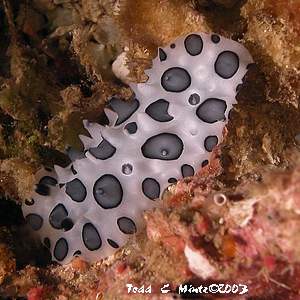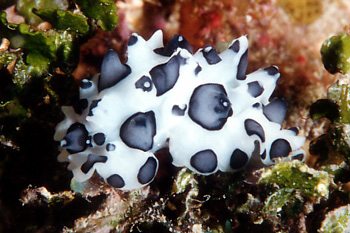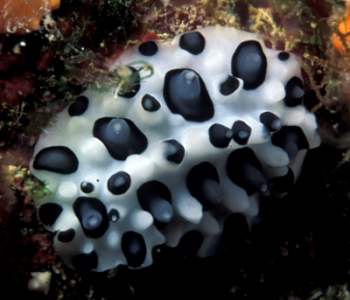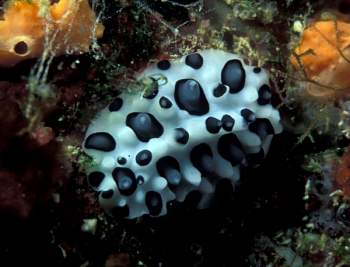

Ceratophyllidia papilligera
(Bergh, 1890)
Order: NUDIBRANCHIA
Suborder: DORIDINA
Superfamily: EUDORIDOIDEA
Family: Phyllidiidae
DISTRIBUTION
Caribbean - West Florida; Gulf of Mexico, Costa Rica; Bahamas: Grand Bahama Island; Cuba; Cayman Islands: Little Cayman; Jamaica; Virgin Islands.
PHOTO
Upper: Roatan, Honduras. February, 2003. Photo: Todd Mintz. Lower: Roatan, Honduras, approx 10-15 meters, November 2001. Approx 30 mm in length. Photo: Boo Nilsson
Formerly known as Phyllidiopsis papilligera, recent studies have concluded that it is better placed in the genus Ceratophyllidia [see Valdes & Gosliner (1999), and message below]. Body white with scattered greyish black spots of varying size. The mantle is covered with short rounded tubercles, those in black spots being black with white tips. Grows to approx 5cm long.
References:
• Bergh, R. 1890 Reports on the results of dredging, under the supervision of Alexander
Agassiz, in the Gulf of Mexico (1877-78) and in the Caribbean Sea (1879-80), by the U. S. Coast Survey Steamer "Blake," Bulletin of the Museum of Comparative Zoology, 19: 155-181, 3 pls.
• Valdes, A. & Gosliner, T.M. (1999): Phylogeny of the radula-less dorids (Mollusca, Nudibranchia), with the description of a new genus and a new family. Zoologica Scripta, 28: 315-360.
Rudman, W.B., 2002 (May 2) Ceratophyllidia papilligera (Bergh, 1890) . [In] Sea Slug Forum. Australian Museum, Sydney. Available from http://www.seaslugforum.net/find/cerapapi
Related messages
Ceratophyllidia papilligera from Cuba
September 22, 2003
From: Elaine


I am enclosing a photo of what I am pretty sure is a black spotted nudibranch. He seemed to have a ridge down his back, which confused me a little when I was trying to make a positive ID.
This photo was taken near the Cay Sal Banks north of Cuba. He was on a steep wall at about 60ft.
Elaine
klpdvr@msn.com
Elaine, 2003 (Sep 22) Ceratophyllidia papilligera from Cuba. [Message in] Sea Slug Forum. Australian Museum, Sydney. Available from http://www.seaslugforum.net/find/11012Dear Elaine,
If by 'black-spotted nudibranch' you mean Ceratophyllidia papilligera, that is indeed what you have found. Thanks for the photo. Any other nudibranch photos you have from the region would also be welcome
Best wishes
Bill Rudman
Ceratophyllidia papilligera from Honduras
September 11, 2003
From: Marli Wakeling

Hi Bill,
A friend found several of these critters in Honduras and I thought it was interesting. It appears to be the same as one in Humann's Reef Creature reference,listed as Phyllidiopsis papilligera, commonly called 'black spotted nudibranch'.
Location: Roatan, Honduras
Date: February, 2003
Photo: Todd Mintz
Regards,
Marli Wakeling
scubamarli@excite.com
Wakeling, M., 2003 (Sep 11) Ceratophyllidia papilligera from Honduras. [Message in] Sea Slug Forum. Australian Museum, Sydney. Available from http://www.seaslugforum.net/find/10940Thanks Marli,
As I discuss in a separate message, this species is now considered better placed in the genus Ceratophyllidia.
Best wishes
Bill Rudman
Phyllidiopsis papilligera from Honduras
May 4, 2002
From: Boo Nilsson

Noticed that you do not have a picture of a Phyllidopsis papilligera so I enclosed one. In some literature Phyllidopsis papilligera is referred to as Ceratophyllidia papilligera. Any idea what is the correct name?
The picture was taken in Roatan, Honduras in about 10-15 meters in November 2001. The specimen is about 30 mm in length. This is a fairly common nudibranch in this area.
Boo
boonilsson@cox.net
Nilsson, B., 2002 (May 4) Phyllidiopsis papilligera from Honduras. [Message in] Sea Slug Forum. Australian Museum, Sydney. Available from http://www.seaslugforum.net/find/6792Thanks Boo,
It's always nice to have a gap filled. Concerning its name. Until quite recently it was known as Phyllidopsis papilligera but recently studies on its anatomy, especially the glands of the foregut suggest it is more appropriately placed in the genus Ceratophyllidia. While one aim of biological nomenclature is to provide a stable name for each species, another aim is to ensure the name reflects the phylogenetic [evolutionary] history of the species. So sometimes when we study the anatomy of a group it means moving species from one genus to another to better reflect their evolutionary relationships.
Any other contributions from Honduras would be very welcome.
Best wishes,
Bill Rudman
Discodoris atromaculata? from Puerto Rico
March 14, 2002
From: Joseph Millevolte
Please correct me if I am wrong but I believe I saw a Discodoris atromaculata off the southwestern coast of Puerto Rico, near the village of Parquera. I made the sighting at a depth of 25m on a coral reef. The specimen was about 40mm in length, oval in shape, almost round and about 4mm thick. The color was very bright white with ink black spots distributed on the mantle. The black spots were about size of the medium size spots on the specimen displayed in second photo and were of uniform size. Also, the spots appeared to be raised slightly giving the mantle a bumpy texture. I am sorry I didn't make a note of what substance it was on, or any other pertinent observations, as I was quite low on air at the time of sighting.
Joseph
joey@millevolte.com
Millevolte, J., 2002 (Mar 14) Discodoris atromaculata? from Puerto Rico. [Message in] Sea Slug Forum. Australian Museum, Sydney. Available from http://www.seaslugforum.net/find/6355Dear Joseph,
Without a photo it's a bit of a guess, but one possibility is Phyllidiopsis papilligera Bergh, 1890 which unfortunately I don't have a photo of. There is a good one in Paul Humann's book [p243]. It is white with large rounded black spots, and scattered white tubercles. I don't know of D. atromaculata been reported from the Caribbean. It is of course possible that it does occur there, but without a photo or specimen there is no way of confirming it.
Best wishes,
Bill Rudman
